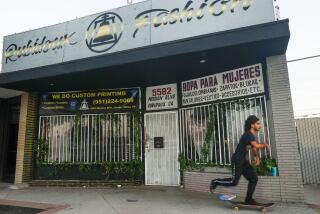Finally, transparency in the Ruben Salazar case
Ruben Salazar had been lying on the floor of the Silver Dollar Bar for nearly three hours when a pair of homicide detectives from the Los Angeles County Sheriff’s Department finally arrived to examine his body.
It was Aug. 29, 1970. Night had fallen. The bar was dark and still stank of tear gas, so Dets. Donald Cannon and Conrad Alvarez donned masks and used “battle lamp” flashlights. Among the many facts in their report — the position of Salazar’s body, the location of the tear-gas canister that killed him — they noted the button pinned to his jacket:
“Chicano Moratorium. 8,000 Dead. Ya Basta! [Enough Already!]” Ruben Salazar had written several columns in support of Chicano activists opposed to the Vietnam War. Even in death, he was proclaiming his solidarity with their cause.
I found that small detail this week amid the hundreds of pages of documents from the Sheriff’s Department investigation of the killing. They were released earlier this year, after decades of pressure from Eastside activists.
Ruben Salazar was a columnist for The Times and also news director at KMEX, L.A.’s pioneering Spanish-language television station. He was the city’s leading Latino media voice, and he had been critical of police abuse. His death on a day of protest for Chicano rights has always seemed suspicious to the people who knew him.
This week, I finally got around to seeing the sheriff’s files myself.
Just about everything I saw smacks of an accident — a tragic and unlikely series of events set in motion by a bystander who thought he saw armed men enter the bar.
Four hours after first encountering Salazar’s body, Cannon and Alvarez interviewed Deputy Thomas Wilson, the man responsible for his death. Assigned to the Montrose station, Wilson had volunteered to help out with crowd control that day.
Wilson said he aimed a tear-gas gun at the bar entrance to get the suspected gunmen to come out (witnesses inside later told detectives they had seen no gunmen).
“When I fired the first round … I observed a hole appear in the curtain where the round had been fired through,” he said.
It was 1:15 a.m. on Aug. 30, and in the transcript of the interview, filled with verbal hesitations, I could almost feel Wilson’s nervousness. He’d just fired a lethal missile into a room he knew to be crowded with people, without being able to see precisely where he was aiming.
You can’t deliberately strike a target if you can’t see it. The projectile passed through Salazar’s skull. And the next day, an autopsy found inside his brain what appeared to be fibers from the curtain.
If that missile had passed a few inches higher, it would have grazed Salazar and he would have survived to write a column for The Times excoriating the Sheriff’s Department. After all, just hours earlier, he’d seen a largely peaceful gathering at an East L.A. park dispersed by baton-wielding deputies.
“The same law enforcement agency that chased after grandmothers and taco vendors in the park with nightsticks,” he might have written, “nearly killed me at a bar a few hours later.”
And yet there’s a lot in the department’s Salazar files that’s troubling.
Many of the documents reek of the paranoia of the day, common to so many American institutions in the Nixon era, when law enforcement saw it as their duty to harass dissenting groups. You can understand why a lot of people suspected Salazar was assassinated.
There’s clear evidence of the “us versus them” mentality in the department.
Lt. Richard Wallace, assigned to the East L.A. station, describes encountering two deputies who had “riled the crowd” by confiscating a flag and armbands belonging to the march organizers.
“I told [the deputy] that I thought it was a pretty stupid trick and that I had expected better of him,” Wallace said. Later, Wallace observed a helicopter hovering just 200 feet over the crowd, provoking much anger below.
Much of the file is filled with accounts of the scattered rioting on the Eastside that day.
But what does all that have to do with the investigation of Salazar’s death?
Nothing, really. The clear purpose, it seems to me, was to justify Deputy Wilson’s panicked and bumbling actions.
You can see one unnamed Sheriff’s Department higher-up preparing that argument in another document in the file: a draft report that includes passages that are typewritten and handwritten and glued together on 13 sheets.
“Deputy Wilson believed that the use of tear gas was the only course of action ... to ‘protect himself [sic], the other deputies, and to protect the people that were across the street … although they were throwing rocks at us,’ ” the draft reads.
Salazar’s death wasn’t a murder. But it was a stupid and entirely preventable accident. No action was taken against Wilson, though Los Angeles County did pay $700,000 to the Salazar family to settle a wrongful-death lawsuit.
In February, an official review of the case found much to criticize in the department’s actions.
“It was not an era of openness and public transparency,” wrote the Los Angeles County Office of Independent Review. “The Sheriff’s Department … circled the wagon around its deputies...”
Eventually, L.A. came to embrace the kind of accountability of law enforcement that Salazar and so many other voices of his day demanded, and it’s fitting that among the first members of the public to see the Salazar documents were several veterans of the 1970 Chicano Moratorium itself. Each was allowed to examine the files for four hours.
There were no time constraints placed on my viewing of the documents in digital form, and others should be allowed to see this material as freely. It shouldn’t take much effort to provide to UCLA, Cal State Northridge and other universities the same digital copies that were given to me.
The Sheriff’s Department has been moving toward openness on the Salazar case for several months now; a few more steps could complete the journey.
More to Read
Sign up for Essential California
The most important California stories and recommendations in your inbox every morning.
You may occasionally receive promotional content from the Los Angeles Times.











